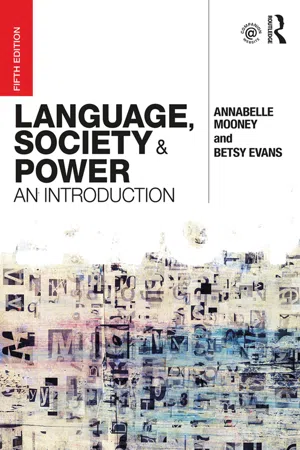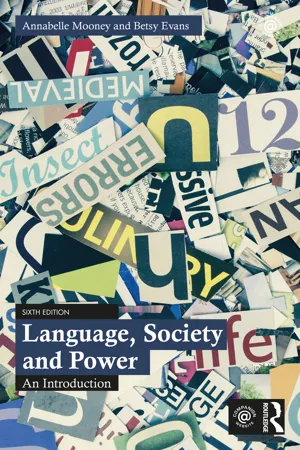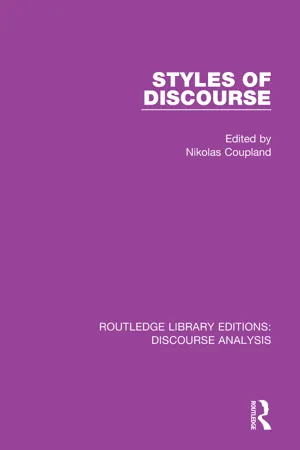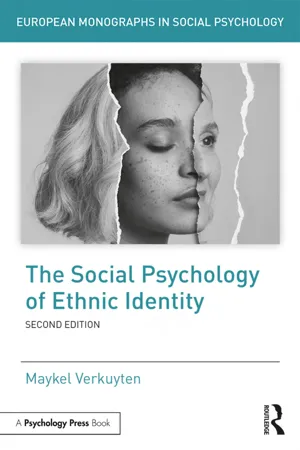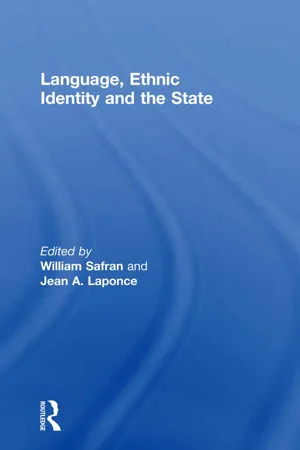Languages & Linguistics
Language and Ethnicity
Language and ethnicity refer to the relationship between language and cultural identity. It explores how language is used to express and maintain ethnic identity, as well as how ethnic groups may have distinct linguistic features. This field of study examines the intersection of language, ethnicity, and social dynamics, shedding light on the complex ways in which language reflects and shapes ethnic identity.
Written by Perlego with AI-assistance
Related key terms
Related key terms
1 of 4
Related key terms
1 of 3
8 Key excerpts on "Language and Ethnicity"
- eBook - ePub
Language, Society and Power
An Introduction
- Annabelle Mooney, Betsy Evans(Authors)
- 2018(Publication Date)
- Routledge(Publisher)
Chapter 7Language and Ethnicity7.1 INTRODUCTION 7.2 WHAT DO WE MEAN BY ‘ETHNICITY’? 7.3 ETHNICITY, THE NATION STATE AND MULTILINGUALISM 7.4 RACISM AND REPRESENTATIONS OF ETHNICITY 7.5 ETHNICITY AND LANGUAGE VARIATION 7.6 ETHNICITY AND IDENTITY 7.7 CONSEQUENCES FOR ETHNOLECTS 7.8 CROSSING 7.9 SUPERDIVERSITY 7.10 SUMMARY7.1 IntroductionHolmes notes that people may ‘signal their ethnicity by the language they choose to use’ (2008: 183). In this chapter, we examine the various ways ethnicity may be expressed and communicated through language. We’ll consider how the position of ethnic groups in the social hierarchy is reflected by language use. As with other variables, such as gender, class and age, a person’s ethnicity has at times been treated as a simple part of their essential nature – stable, determined and unchanging. It is true that some research shows a correlation between particular linguistic variables and ethnicity. However, we will see that it’s not always quite so straightforward. How individuals articulate their ethnicity and how it is understood may vary because of the communicative context they’re in, the people they’re interacting with. Ethnicity may also interact with other aspects of identity, such as gender, age, sex and so on.
It’s useful to have a sense of what the term ‘ethnicity’ includes. Allan Bell notes that ethnicity ‘is one of the most slippery social dimensions’ (2014: 173). He continues:7.2 What Do We Mean By ‘Ethnicity’?[Ethnicity] has to do with a group sharing sociocultural characteristics – a sense of place, ancestry, a common history, religion, cultural practices, ways of communicating, and often a language. When sociolinguists question their informants about ethnicity, they are nowadays most likely to ask what ethnic group a person identifies with, indicating the socially constructed nature of ethnicity.(2014: 173–174)If you are part of the ethnic majority, you probably don’t even consider that you have an ethnicity. But as with accents, we all have an ethnicity. Again, if you are part of the ethnic majority, the only time you think about ethnicity might be when filling in forms that specifically ask you for your background. The categories that are chosen and the way they are labelled can reveal a great deal about the makeup of a particular nation and the characteristics it sees as relevant. They can present a challenge though, as they often treat ‘race’ as synonymous with ethnicity. While ‘race’ is connected to biology and physical characteristics, ethnicity is far more appropriate in understanding how people align with sociocultural groups, how they construct their identity and how they use language to do this. - eBook - ePub
Language, Society and Power
An Introduction
- Annabelle Mooney, Betsy Evans(Authors)
- 2023(Publication Date)
- Routledge(Publisher)
CHAPTER 7 Language and EthnicityDOI: 10.4324/9781003120957-7CONTENTS
7.1 INTRODUCTION7.2 WHAT DO WE MEAN BY ‘ETHNICITY’?7.3 RACISM AND REPRESENTATIONS OF ETHNICITY7.4 ETHNICITY AND LANGUAGE VARIATION7.5 ETHNICITY AND IDENTITY7.6 CONSEQUENCES FOR ETHNOLINGUISTIC REPERTOIRES7.7 SUMMARY7.1 INTRODUCTION
Holmes notes that people may ‘signal their ethnicity by the language they choose to use’ (2008: 183). In this chapter, we examine the various ways ethnicity may be expressed and communicated through language. We’ll consider how the position of ethnic groups in the social hierarchy is reflected by language use. As with other variables, such as gender, class, and age, a person’s ethnicity has, at times, been treated as a simple part of their essential nature – stable, determined, and unchanging. It is true that some research shows a correlation between particular linguistic variables and ethnicity. However, we will see that it’s not always quite so straightforward. How individuals articulate their ethnicity and how it is understood may vary because of the communicative context they’re in and the people they’re interacting with. Ethnicity may also interact with other aspects of identity, such as gender, age, sex, and so on. As we noted in Chapter 6 , scholars refer to this complexity of identity as ‘intersectionality’ (Crenshaw, 1989 ; Levon, 2015 ).7.2 WHAT DO WE MEAN BY ‘ETHNICITY’?
It’s useful to have a sense of what the term ‘ethnicity’ includes. Allan Bell notes that ethnicity ‘is one of the most slippery social dimensions’ (2014: 173). He continues:[Ethnicity] has to do with a group sharing sociocultural characteristics – a sense of place, ancestry, a common history, religion, cultural practices, ways of communicating, and often a language. When sociolinguists question their informants about ethnicity, they are nowadays most likely to ask what ethnic group a person identifies with, indicating the socially constructed nature of ethnicity. - eBook - ePub
- John Edwards(Author)
- 2002(Publication Date)
- Routledge(Publisher)
5 LANGUAGES AND IDENTITIES
I have discussed in general terms the fortunes of languages in contact, and one of the clearest matters to emerge is the place of language within the larger social context. The symbolic attachments to language were mentioned, as was its interrelationship with other cultural aspects of life. What we observe, in a word, is the intertwining of language with group identity and it is to this that I wish to turn now in some greater detail; specifically, we should consider ethnic and national affiliations, and the role of language within them.ETHNICITY
At a very simple level, ethnicity can be thought of as a ‘sense of group identity deriving from real or perceived common bonds such as language, race or religion’. But, although true, this definition is very general and invites more questions than it answers. What, for example, are the most important common bonds? Are some more central than others? Are some essential? And why exactly is the phrase ‘real or perceived’ necessary? If we turn to the extensive literature on ethnic identity, attempting to resolve these matters, we find that we have opened Pandora’s box. An examination of sixty-five studies of ethnicity found that fifty-two of them gave no explicit definition of ethnicity, accepting, by default as it were, the sort of general view cited above.1 In theoretical treatments of the subject, a broad range of opinion emerges, but several themes recur and it is an examination of these that promises to lead to a comprehensive definition of identity.First, there is the often-expressed equation of ethnic group with minority group, or with a social subgroup. Yet, even the most casual observer can see that all people are members of some ethnic group or other. Ethnos is a Greek word for ‘nation’, where this signifies a common-descent group, but historically it was also associated with outsiders or barbarians. Dr Johnson defined ‘ethnic’ as ‘heathen; pagan; not Jewish; not Christian’. Perhaps a lingering sense of this has contributed to the sometimes pejorative usage of the term ‘ethnic group’. Nowadays, the politics of power often means that dominant groups rarely define themselves as ethnic groups. None the less, it is a logical fallacy to think of ethnicity as a minority phenomenon; while dominant groups in mixed societies may not usually consider themselves in ethnic terms, they clearly can - eBook - ePub
- Farzad Sharifian, Farzad Sharifian(Authors)
- 2014(Publication Date)
- Routledge(Publisher)
1 Language and Culture: Overview
Farzad Sharifian DOI: 10.4324/9781315793993-1Interest in studying the relationship between language and culture can be traced back at least to the eighteenth century. Wilhelm Von Humboldt (1767–1835), Franz Boas (1858–1942), Edward Sapir (1884–1939), and Benjamin Whorf (1897–1941) are prominent scholars who all emphasized the relationship between language, thought, and culture. However, a unified subdiscipline focusing on the relationship between language and culture has never been fully developed. Taking the US alone, Duranti (2003) distinguishes between three different paradigms in the history of the study of language as culture, which is summarized in Table 1.1 .Table 1.1 Three different paradigms in the history of the study of language as culture(Duranti, 2003)Focus View of language Associated labels Documentation, description, and classification of indigenous languages Language as lexicon and grammar Anthropological linguistics Language use in context Language as a culturally organized and culturally organizing domain Linguistic anthropology, ethnography of speaking Identity formation, narrative, and ideology Language as an interactional achievement filled with indexical values Social constructivism Although Duranti associates the development of each paradigm with a certain period in history, he maintains that all three paradigms persist today. As for the labels, Duranti (2009 : 33) notes that the term ‘ethnolinguistics’ has been a popular term in Europe for studies of language and culture (see Underhill, 2012 ). No matter which label or which theoretical orientation is adopted to study the relationship between language and culture, the difficulty in defining both terms has partly contributed to the immature development of a unified sub-discipline for the study of language and culture. Views of language have in the past century ranged from language as a cognitive system/faculty of the mind, to language as action, language as social practice, language as a complex adaptive system, etc. Culture has similarly been viewed differently by different schools of thought. It has been seen, for example, as a cognitive system, as a symbolic system, as social practice, or as a construct (see Foley, 1997 ; and Chapters 10 and 28 - eBook - ePub
- Nikolas Coupland(Author)
- 2016(Publication Date)
- Routledge(Publisher)
These characteristics were not drawn upon at random but were enacted by an eminent judge, Lord Fraser. It is interesting that it was the work of a legal person rather than a social scientist that was called upon to establish the nature of an ethnic group. Of course either side involved in the Tribunal could have used the services of expert witnesses with reference to this or any other issue if they so wished. Indeed, as we shall see, one member of the Tribunal was elected for his expertise with reference to matters of ethnicity. The defence chose not to resort to such an expertise and, in so doing, deferred to the legal definition, a definition which placed severe constraints on the discussion of the relationship between Language and Ethnicity.Two further paragraphs refer to Lord Fraser's attempt to come to terms with the nature of ethnicity:- 81 ... a group is identifiable in terms of its ethnic
- 82 origins if it is a segment of the population
- 83 distinguished from others by a sufficient
- 84 combination of shared customs, beliefs, traditions
- 85 and characteristics derived from a common or
- 86 presumed common past, even if not drawn from what
- 87 in biological terms is a common racial stock.
- 88 It is that combination which gives them
- 89 an historically determined social identity in their
- 90 own eyes and in the eyes of those outside the
- 91 group, they have a distinct identity based not
- 92 simply on a group cohesion and solidarity but also
- 93 on their belief as to their historical antecedents.
It is evident that a distinction is drawn between ethnicity and race. Also it would seem that the racial group is part of something while also being different from the 'others' which, together with it, constitute that something. What marks this difference are the shared traits involving customs/beliefs/traditions/ characteristics which have a historical referent. It seems that the entirety consists of the sum of ethnic groups and that at some time in the past these groups were separate, whereas they are now drawn together into some form of unity. The process whereby this historic change has taken place is not specified. The ethnic group is cohesive and solidaristic, something which, in relation to social identity, is separate from 'belief in historical antecedent'. Thus social identity can derive from a sense of cohesion and solidarity or from beliefs. Yet it would seem that both are in a sense 'beliefs' but that one is derived from the collective memory and the other from the present. Again we do not know what, in the present, generates this cohesion and solidarity. It is this social identity which seems to constitute ethnicity which at the same time is the shared customs, beliefs, traditions and characteristics. The whole argument seems to be tautological. - eBook - ePub
- Maykel Verkuyten(Author)
- 2018(Publication Date)
- Routledge(Publisher)
10Although ethnicity and culture should not be equated, it is clear that boundaries and social interactions across and between these boundaries are intimately bound up with the cultural contents of ethnicity (Jenkins, 1997). This is also acknowledged by Barth (1994, pp. 17, 18) in looking back at his original writing: ‘[T]he issue of cultural content versus boundary, as it was formulated, unintentionally served to mislead’, while ‘central and culturally valued institutions and activities in an ethnic group may be deeply involved in its boundary maintenance’. The shared culture, together with the actual community life, are key to group stability and the strength and persistence of ethnic attachments. They are often what make ethnic identities really meaningful and matter. However, there is an additional aspect that (as discussed) defines the notion of ethnicity and which can make ethnicity psychologically and socially quite meaningful: the ideology of membership by descent. Although not thematized, it was also recognized by Barth (1969, p. 13) in describing ethnic ascriptions as classifying ‘a person in terms of his basic, most general identity, presumptively determined by his origin and background’.p.58 The genealogical dimensionRoosens (1994, 1998) acknowledges the importance of situated interaction and of Barth’s boundary metaphor as it is used by many anthropologists. But he also points out that this metaphor tends to ignore the specific nature of ethnicity. After all, constructing boundaries with cultural markers is not specific to ethnic groups. This occurs with all kinds of groups, from youth cultures and sports clubs to companies and organizations. An example of this is provided by Cohen (1974), who regards the stockbrokers who work in the City of London as an ethnic group. The result of this is that the specific character of ethnicity disappears and ethnicity is treated as any other group that draws boundaries and shares some patterns of normative behaviour. - eBook - ePub
Language and Nationality
Social Inferences, Cultural Differences, and Linguistic Misconceptions
- Pietro Bortone(Author)
- 2021(Publication Date)
- Bloomsbury Academic(Publisher)
4 Linguistic diversity The different features of other languagesIf differences in language mark and reflect differences in nationality or national identity, it is important to have some awareness of the dissimilarities that exist between languages. This may help us understand which connections exist – and which do not – between languages and the populations that speak them natively. It is often stated in linguistics textbooks of various schools (and repeated in academic books of other fields) that ‘human languages are surprisingly similar’ and that ‘all known languages are at a similar level of complexity and detail’ (Akmajian et al. 2017: 9); indeed, that ‘[a] central finding of linguistics has been that all languages, both ancient and modern, spoken by both “primitive” and “advanced” societies, are equally complex in their structure’ (Forston 2010: 4). Already in the 1950s, it was standard to say that ‘impressionistically … the total grammatical complexity of any language, counting both morphology and syntax, is about the same as that of any other’ (Hockett 1958: 180). These statements can be questioned. Different languages are not merely alternative collections of words with which one can say the same thing. And they can be dramatically unlike one another not only in their vocabulary but also in their structures; parts of the vocabulary and structure of one may even have no equivalent in the other. Moreover, as we shall see, such lexical and grammatical idiosyncracies serve certain useful functions, and can be linked to social and cultural particularities of each linguistic community. The fact that a language may have a word for something that another language lacks, or that it may have the ability to express particular conceptual distinctions through its grammatical forms which other languages cannot, is not only useful for its speakers but also instructive for everyone else. The comparative study of languages shows that many concepts that one may imagine to be universal are not so, and that words or expressions that are assumed to be equivalent across languages (and therefore to be good translations) may also not be so: a real equivalent may be lacking, and near-equivalents may have different connotations that tell us something about the culture, the society, and the history of the speakers. In our own language too (whichever that be), words that we presume to be neutral can carry cultural and ideological assumptions, and we shall look at examples of this. There is also much variation in how languages are used in practice. Each community may have different notions of what is appropriate and normal: different speaking styles, tones of voice, paces of conversation, ways of articulating statements, requests, orders, wishes, and compliments, or of indicating disagreement, assent, gratitude, annoyance, solidarity, and much besides. All this also contributes to the way different nationalities and ethnicities perceive, and indeed stereotype, one another. As we will see in Chapter 5 , the etymology of words specific to each language can also embed and reveal a lot about the history, geography, and outlook of the speakers. And since languages can differ in their default ways of describing reality and of framing issues, it is fair to ask whether being a (monolingual) speaker of a particular language constrains or dictates the way one thinks; the belief that it does was the standard opinion in the nineteenth and early twentieth centuries, and then came to be denied as patent nonsense; there is, however, some evidence that, in very small ways, it may be true – as we shall discuss in Chapter 6 - eBook - ePub
- William Safran, J.A. Laponce(Authors)
- 2014(Publication Date)
- Routledge(Publisher)
INTRODUCTION: THE POLITICAL ASPECTS OF LANGUAGEWILLIAM SAFRAN
University of Colorado, Boulder, ColoradoLanguage is a marker of ethnic identity; a vehicle for expressing a distinct culture; a source of national cohesion; and an instrument for building political community. Yet the relationship between language and ethnonational identity is a contested matter. There is no question that language is one of the elements defining collective consciousness, the others being religion, history, common descent, and territory. In the 19th century, language was considered the major defining factor of a nation, at least in Europe; and it was almost taken for granted that each linguistic community deserved to have its own state. The German language was a crucial element in politically mobilizing a number of kingdoms, duchies, and city-states in central Europe toward a national state, the fight against Napoleon being the proximate mobilizing event. However, pan-Germanic unity—the unification of Germany and Austria—was blocked by dynastic and religious rivalries, and its achievement under Hitler was short-lived. Language was the most important force for Italian political unity; but the imposition of standard Italian has not prevented the survival of regional idioms, nor has it been sufficient for overcoming the economic, social, and cultural divisions between northern Italy and the Mezzogiorno. Conversely, the collapse of unity in post-Tito Yugoslavia must not be attributed entirely, and perhaps even primarily, to linguistic divisions, for the conflicts among the components of that state also had religious, historical, and other translinguistic causes.In the opinion of T.R. Gurr, “language issues alone are not a common source of deadly rivalries, because language differences, unlike racial and religious ones, are subject to individual and collective compromises. Individuals in heterogeneous societies can and ordinarily do speak several languages, but they cannot be both black and white or both Hindu and Muslim.”1
Index pages curate the most relevant extracts from our library of academic textbooks. They’ve been created using an in-house natural language model (NLM), each adding context and meaning to key research topics.
Explore more topic indexes
Explore more topic indexes
1 of 6
Explore more topic indexes
1 of 4
